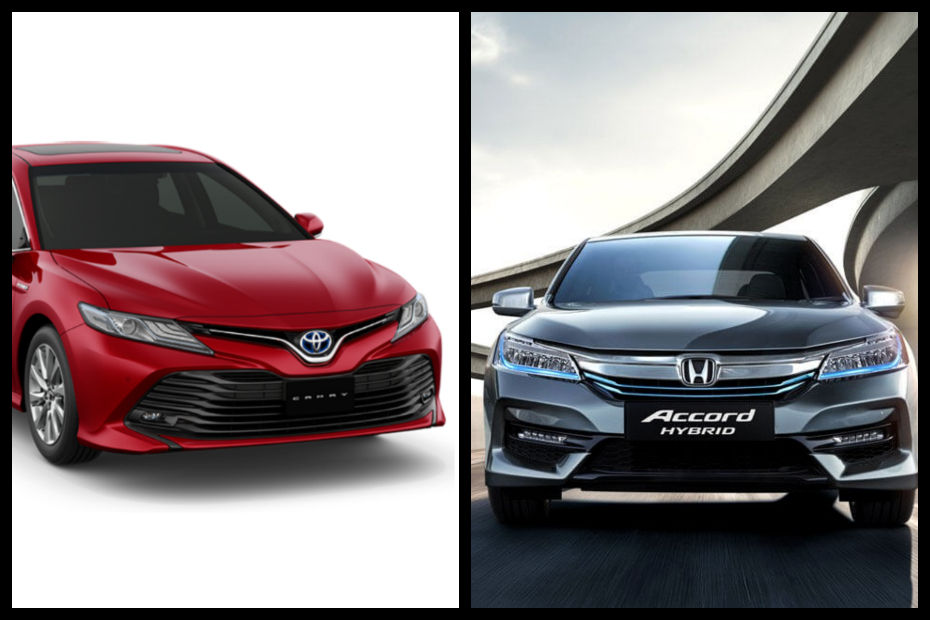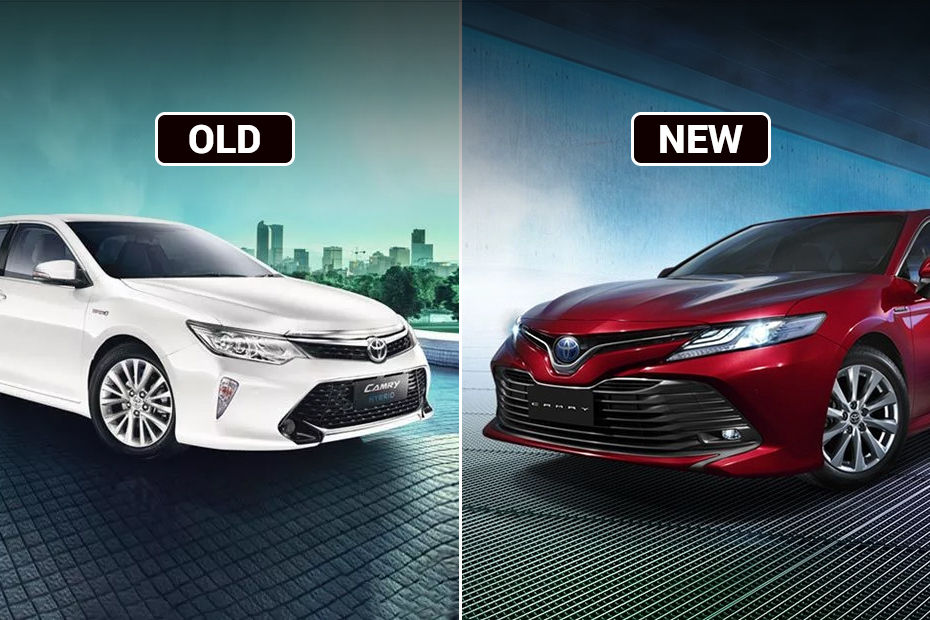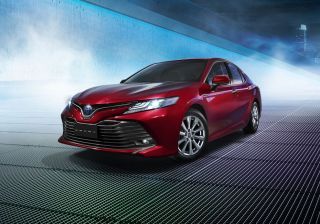2019 Toyota Camry Hybrid: First Look
Modified On Jan 23, 2019 11:21 AM By Sonny
- Write a comment
We get in and around the new Camry at its launch to see what’s new
Toyota has launched the new Camry Hybrid at an introductory price of Rs 36.95 lakh (ex-showroom, India). That’s actually lower than the price of the outgoing model by Rs 27,000.
It’s also the only variant of the Camry that will be offered in India as Toyota does not plan to bring a petrol-only option, which was available on the outgoing model, this time round. You can read about the details and figures in our comparison between the new and outgoing models here.

So, what’s our first impression of the bigger, more fuel efficient and prettier Camry Hybrid?
Exteriors
The new Camry is based on Toyota’s new TNGA platform and the exteriors have been given a thorough update. It gets a new V-shaped front grille with new LED projector headlamps and LED daytime running lights which are not only functionally better but also make the Camry look modern and up-to-date as a premium sedan. It even gets front LED fog lamps fitted in the wider front air dam.

Around the back, the LED tail lamps are now sleeker in design with the turn indicator section now housed between the brake lights instead of on top of them. These lights are still bridged by a bar of chrome on the bootlid of the updated rear bumper design which also houses the rear fog lamps.

From the side profile, the new Camry looks more elegant than before, much like its posh twin, the Lexus ES300. The edges are smoother and the car is notably lower and longer, giving it a presence similar to that of a car that would cost almost twice as much. Another notable design change is that the ORVMs are mounted to the door and not directly along the window line as was the case before. This too gives it a wider and more prominent stance.

Interiors & Seating
This is the most important factor in the appeal of the Toyota Camry, which has sold more than 11,000 units in India since its launch. While Toyota claims that the new Camry gets improved driving dynamics for a more enjoyable driving experience, the carmaker admitted that the Camry is more often than not a chauffeur-driven car in the Indian market. Thus, we’ll start at the back.

Toyota stated that the newly designed cabin is more spacious than before and one does feel that as you take a seat in the plush, beige leather upholstery of the new Camry. There is plenty of kneeroom even with the driving seat in front adjusted for someone nearly 6 feet tall but we’ll have to wait before we can get our measuring tape out for the exact numbers. The cool factor is the new touch-sensitive console in the foldable rear centre armrest which we’ll discuss in details later in this article.

The door pulls and footwells are illuminated and while the rear doors do have cubby holes for storage, they no longer offer an ashtray. Much of the support and structure on the inside of the doors gets soft leather instead of wood trim. There is also an easy access control on the shoulder of the front passenger seat which moves and angles it forward for easier ingress behind it.

Moving into the front seat, we are greeted by a new steering wheel with a neat layout for the mounted controls which fit in better with the overall design. The V-shaped front grille design element appears to be applied to the dash as well with the silver strips around the central screen that converge as they flow down towards the central console tunnel. The stone grain and metallic pattern finish on various bits of trim add to the premium feel of the new Camry. The new dashboard layout also adds to the sense of spaciousness in the cabin as the top-most section is quite smooth and uninterrupted.

The ventilated front seats are 10-way power-adjustable with lumbar support while the driver’s seat also gets memory function. The driver’s instrument cluster still gets two analogue dials which flank a new, bigger digital multi-information display for all sorts of infotainment and assist system controls that the driver can toggle through. The central infotainment system comprises of an 8-inch touchscreen display with a range of buttons on either side to navigate the system. There are sleeker and wider air vents above it with the air con controls for the 3-zone climate control underneath the infotainment unit. The glossy black finish contrasts well with the beige interior and is complimented by the blue backlighting. The entire section appears to be angled towards the driver for easier access while on the move.

The design actually creates a bit of a cave under the infotainment and air con controls that houses the wireless charging pad for smartphones. It’s easier access for the driver and it would also prevent the device from sliding off to the left in case of a sharp right turn. There is a covered 12V socket and USB port as well. The controls for the front seat ventilation are right behind the cup holders and ahead of the front armrest. The roof-mounted controls look a lot better too in the new Camry. This is where the user can control the cabin lights and the tilt-and-slide sunroof.

Overall, the cabin of the new Camry with the soft touch leather upholstery is a very pleasant place to be. Most of the buttons and controls in the new Camry appear to be ergonomically designed for the intended users. But at first glance, access to the charging areas in the central console for the front passenger does not seem to be the easiest.

Controls and Features

The steering wheel on the Camry Hybrid continues to be power-adjustable for both tilt and telescopic settings and can also be saved to the memory function with the driver’s seat position.

Toyota’s new infotainment unit with the 8-inch touchscreen has split-screen functionality so you can see what song is playing without switching away from your navigation app. It also connects to your phone via bluetooth for telephony and audio controls. However, it does not support smartphone integration via Android Auto or Apple CarPlay, which is surely to be expected in cars such as this. We’ll let you know about how the Toyota system and the 9-speaker JBL audio system perform in our review later on. Toyota has also equipped the new Camry Hybrid with a 10-inch heads-up display but it was not active with the car’s power switched off.

The driver’s door control panel now has more buttons too in addition to the power windows and central locking. The electrically adjustable ORVMs are now controlled by a dial-and-joystick control with the memory function buttons above them. The steering-mounted controls are for audio, cruise control, multi-information display and telephony with the shift paddles behind it.

Those paddles control the sequential shifts of the E-CVT gearbox which has various buttons below it for driving modes: Eco, Normal and Sport. There is also an EV mode button as well as an e-brake (electronic parking brake).

Moving into the back seat once again, here’s what we know about the cool touch-sensitive control panel in the central armrest. It allows the rear passengers to control the audio settings, the air con for the rear AC vents (3-zone climate control), the recline angle of the rear seats and the rear-screen sunshade. The only physical button is the power switch to toggle it on and off. It also automatically goes into sleep mode to avoid unintentional button pressing.

There are USB charging ports under the rear AC vents. There is one feature that hinders the plush experience and that’s the rear-window shades which are manually operated. It would have been ideal if they were electrically controlled like the rear screen sunshade. It does however get a tilt-and-slide moonroof.

The new Toyota Camry also comes with a lot of safety features which are at work behind the scenes. This includes the 9 SRS airbags, ABS with EBD and brake assist, the vehicle stability and traction control (the off switch is to the right of the steering wheel) and impact-sensing fuel cut-off. Some of the features which we will see in action when we test the car will include the tire pressure monitor and parking assist with rear camera and sensors. The Camry also gets ISOFIX and top tether anchor for child seats as well as front driver and passenger seatbelt warning on the instrument cluster.

Conclusion
From our brief time around the new Camry Hybrid, it looks to be a competitive package in its segment where it rivals the likes of the Skoda Superb and Honda Accord Hybrid. However, this was a parked car and we didn’t get to experience its features in much detail at the launch. So stay tuned to CarDekho for the full detailed review soon.
Also read: Spec Comparison: 2019 Toyota Camry Hybrid Vs Honda Accord Hybrid

Read More on : Camry Automatic















